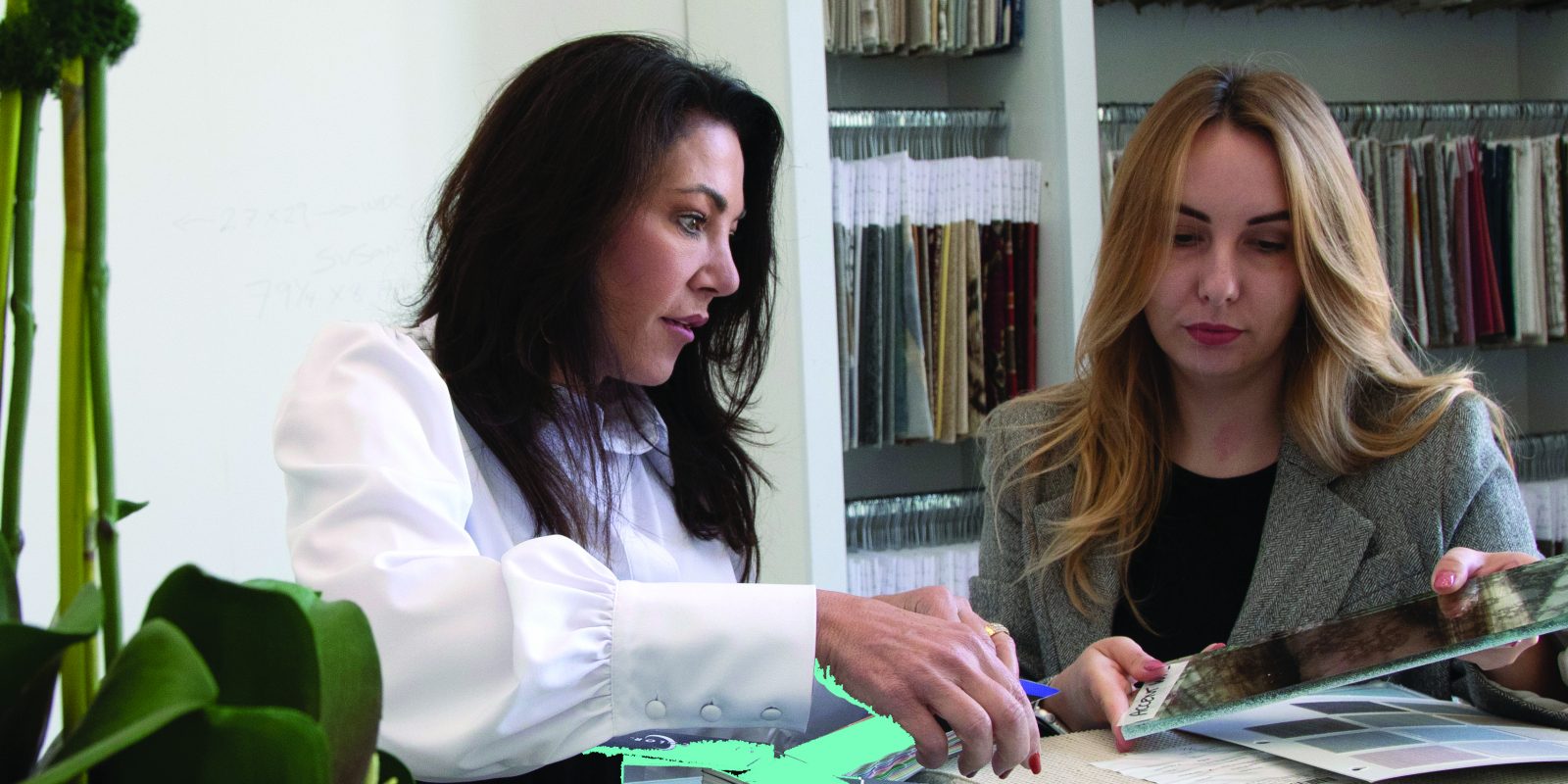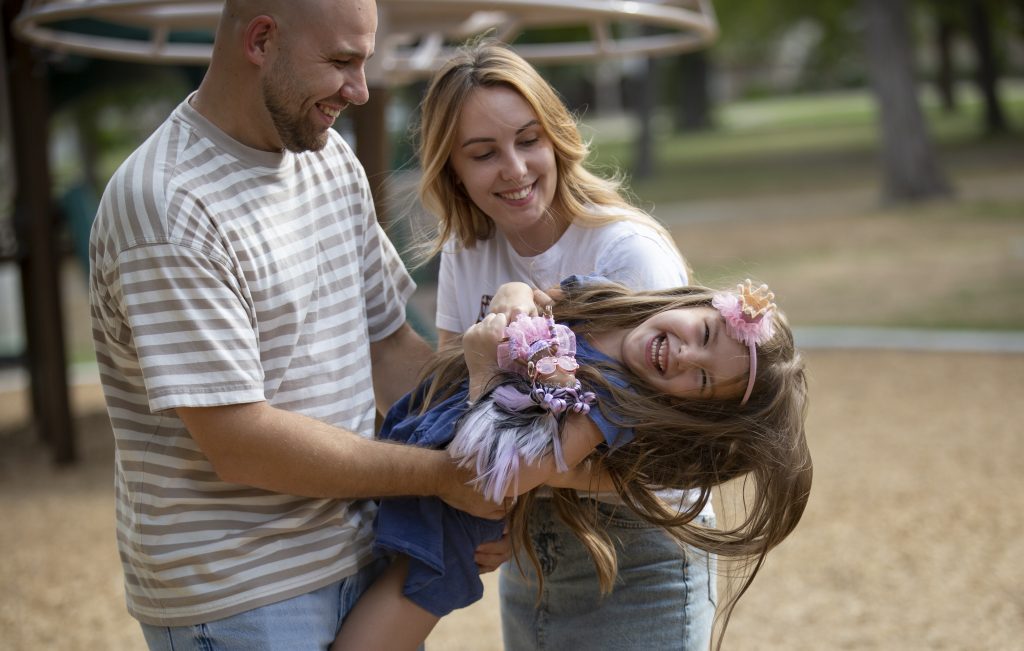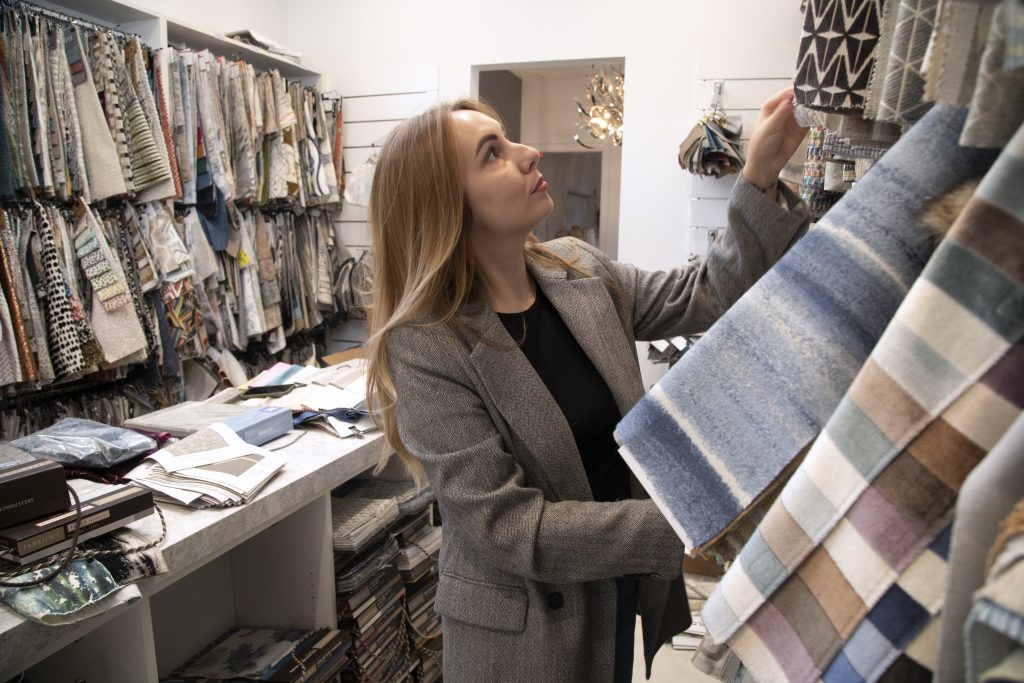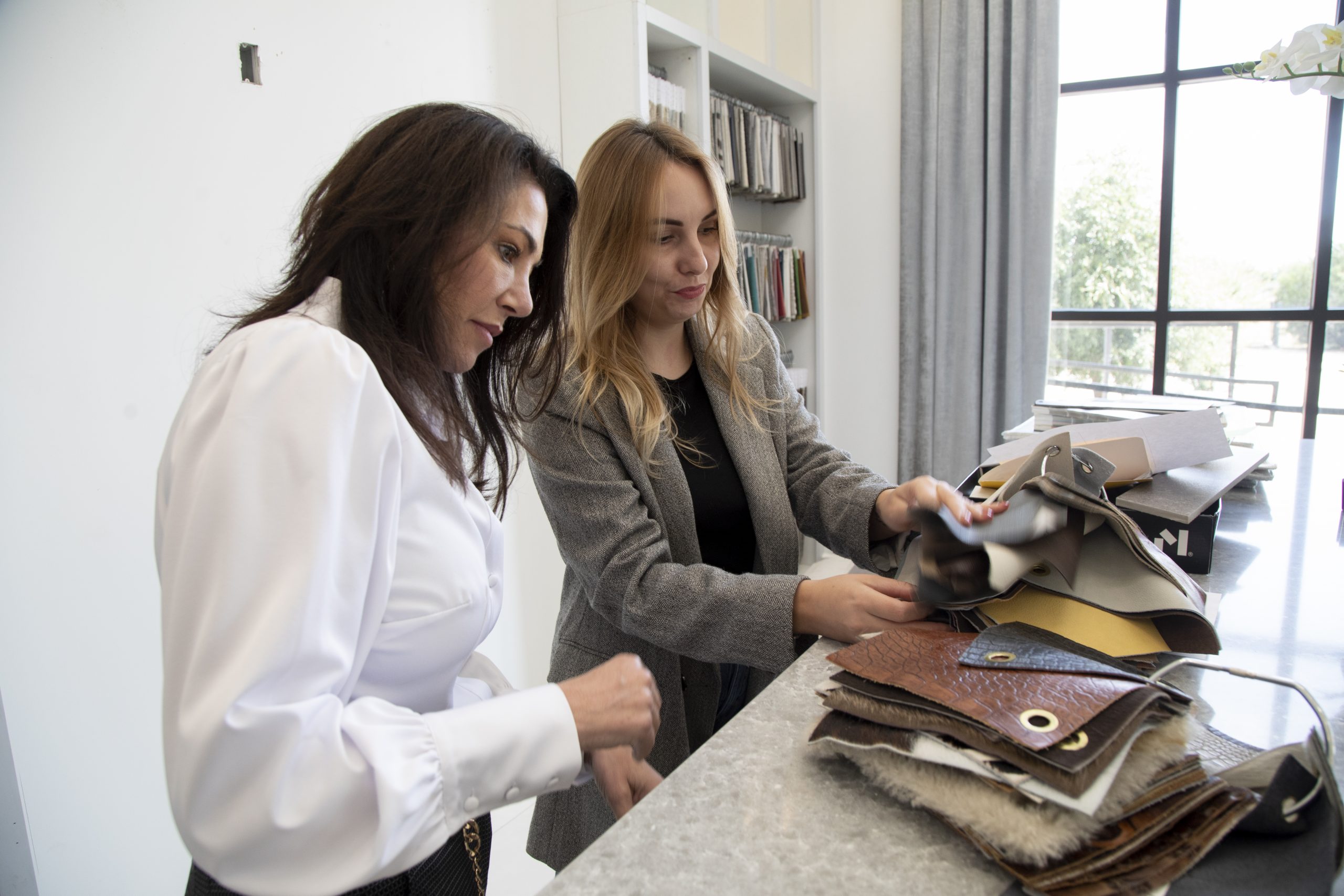
Interior designer Susan Semmelmann, left, offered Ukrainian refugee Olha Khytrenko a job. Khytrenko’s training and talents have made her a key player at the firm, Semmelmann said.
Designing a New Life
With help from TCU alumni, a Ukrainian woman finds a safe haven and opportunities in Fort Worth.
While on maternity leave six years ago in her native Ukraine, Olha Khytrenko realized she was interested in interior design. Pondering a better use of space around her home, she came to understand that the newfound interest wasn’t some passing fancy. Khytrenko was convinced she needed to spend her work life designing home and office spaces.
One problem: She needed formal training, and she already had a bachelor’s degree in philology of foreign languages from Oles Honchar Dnipro National University.
Khytrenko decided to go with her heart and enrolled in school again, following her passion. After graduating, she found a job at T-Design in Dnipro, Ukraine. Life was starting to make more sense. She enjoyed the work and family balance with her husband, Dima, and daughter, Mira.
Then, on Feb. 24, 2022, Russian armed forces invaded Ukraine and shellshocked her life.
The Khytrenkos were among the more than 11 million Ukrainian refugees who have fled their war-torn homes since February 2022, according to the United Nations Refugee Agency’s statistics. They are among an estimated 12,000 of those Ukrainians who now call Texas home.
“We already had a friend in the U.S. who proposed for us to come [to the United States] and helped us find a sponsor,” Khytrenko said. “The sponsor lives in Fort Worth, so we ended up in this city.”

Olha Khytrenko; her husband, Dima; and their daughter, Mira, fled Ukraine after the Russian invasion. “We are no longer afraid of changes,” she said.
When the Khytrenko family arrived in the United States in February 2023, they were matched with the Fort Worth-based BeHumanKindness organization. So far, the group has helped relocate 94 Ukrainians through the Uniting for Ukraine program. The scope of that assistance caught the attention of Jaime Loke, associate professor of journalism at TCU, who integrates the poignant refugee stories into her classroom.
As a special topic of Loke’s longform journalism course, she decided to focus on the war in Ukraine. Loke’s neighbor is a Ukraine native who arrived in Texas decades ago and volunteers to assist Ukrainian refugees. She put Loke in touch with Katie Stadler ’06, founder of BeHumanKindness, to learn of possible families for her class to interview. Stadler was eager to participate.
“She said, ‘Hey, guess what? I have a family that’s arriving from the Ukraine,’” Loke said of that conversation. “I think she gave us just a week’s notice. And I told my students, ‘OK, we’ve got a family coming in. Somebody needs to go to the airport and cover this family because this is a once in a lifetime opportunity for you to capture this family’s journey from the beginning.’ ”
While the Khytrenkos’ apartment was being prepped, they briefly stayed in the home of Loke’s Ukrainian neighbor. After a few nights of getting adjusted, Loke, who has a daughter the same age as Mira, brought her family over to meet them.
“They looked exhausted,” Loke said.
Loke and a host of volunteers eventually helped them settle into their new apartment. They gave it a deep cleaning, made minor repairs and helped purchase household essentials.
Khytrenko’s interior design talent piqued Loke’s interest. So she called Susan Semmelmann ’90 to gauge her interest in helping the new U.S. resident find work. Semmelmann gave a quick yes, and Khytrenko is now able to share her interior design talents with Fort Worth-based Susan Semmelmann Interiors.
“There’s still a language barrier and, frankly, the measurement system isn’t convenient,” Khytrenko said. “But despite this, I ended up with a wonderful team that helped and continues to help me adapt here.”
Migrating for Opportunity
Prior to the Russian invasion, Ukraine boasted a thriving interior design industry. The country’s designers were known for blending traditional aesthetics with modern influences.
“In Ukraine, the design is calmer with minimalist styles,” Khytrenko said. “In the U.S. it’s more of a traditional style, with lots of details and furniture. It’s more colorful and heavier, in my opinion.”

Olha Khytrenko is “able to communicate in full sentences. She has an English tutor that she goes to after work,” Susan Semmelmann said.” So she’s really diving in to be able to communicate and to be able to broaden her spectrum of performance.”
The war between Russia and Ukraine led to difficulties with logistics and the delivery of materials from other countries. As a result, Ukrainians were reluctant or unable to invest in interior design.
Infrastructure damage resulting from bombings and military operations created additional challenges for interior designers. Resources that were available were needed to repair bombed buildings.
Cities like New York, Los Angeles and Miami became popular destinations for Ukrainian refugees in the creative field because of their vibrant design industries and diverse clientele. These cities offered a platform for Ukrainian designers to showcase their talent and expertise while adapting to a different culture.
Migration brought opportunity while presenting numerous challenges. Language barriers hindered effective communication with clients and colleagues. Designers had to invest time and effort into learning English or rely on translators until they gained proficiency in the language.
Khytrenko “had very, very, very limited English when she started,” Semmelmann said. “But now she’s able to communicate in full sentences. She has an English tutor that she goes to after work. So she’s really diving in to be able to communicate and to be able to broaden her spectrum of performance.”
Differences in professional standards between Ukraine and the United States posed another obstacle. Ukrainian designers needed to familiarize themselves with local regulations such as building codes, safety standards and licensing requirements that might differ from those back home.
Given what Khytrenko had been through, she said, learning new design and regulation standards was the least of her concerns.
“I’ve learned some very hard lessons,” she said. “I’ve learned that you can fall asleep in a happy and calm country and wake up to the sounds of explosions and flying rockets, that everything you have built for so long in your life can break at one moment, that you need to learn to build your new life, start from scratch with a small child in a completely different country. We are no longer afraid of changes. We are always ready to move forward.”
Spirit of Giving
Semmelmann said hiring Khytrenko was a double win. As a core business value, Semmelmann regularly practices giving back to help others, but her new employee is also a gifted designer.
“When [Loke] called, I said no matter what she can do, I’m going to make sure she has an opportunity and a job,” Semmelmann said. “We brought her in, and I had no idea what she could or couldn’t do. Well, the joke was on me because here I am thinking I’m doing something great by giving her this opportunity, only to find out that she is an incredible key player in our business and just accelerates day after day after day.”
Semmelmann’s good gesture started long before Loke’s phone call with her business commitment to serve and be helpful. Within the business community, Semmelmann’s kindhearted decision is an example of corporate social responsibility. It’s an intentional pledge to give back, often with no immediate return on the investment of time or resources.
For certain public-facing industries, social responsibility decisions can separate a business from its competitors. Benefits include an improved reputation among stakeholders, customers, employees, investors and the community. Evidence suggests that companies that implement strategic giving initiatives tend to experience better financial performance due to a bolstered reputation and enhanced customer loyalty, which translate into stronger sales and profitability.
“I’ve got such a deep, strong belief that the spirit of living is in the giving,” Semmelmann said. “That’s not just a tagline for me; it’s what I live for. And there’s no greater reward ever in life than when you give.”
Stadler, founder of the BeHumanKindness organization, said she’s had many TCU alumni like Semmelmann partner with her to help Ukrainians.
“Being a part of these families’ lives and seeing the impact that we as Americans can have when we say yes to private sponsorship of families displaced by this crisis is what continues motivating me,” Stadler said. “Walking alongside these families through their immigration and resettlement has been a great joy and blessing to my family and to many of the sponsor families working with BeHumanKindness.”
In speeches, Stadler emphasizes these families’ “unfathomable experiences and journey to get to the United States to begin a new life.”
“Knowing that we can use the blessings we have been given to bless others drives me, our family and our organization’s mission to keep welcoming families who are looking for safety and an opportunity to create a future life,” she said.
“Life is too short and it’s too precious to not get it,” Semmelmann said of helping others. “We’re here for a very short time. And what we do with our time needs to be something that’s impactful to other people.”

Thanks to the assistance offered by many TCU alumni, including Susan Semmelmann, Olha Khytrenko, right, said she and her family “are always ready to move forward.”

Your comments are welcome
1 Comment
What a wonderful way to exemplify the “spirit of living is in the giving “. So proud of you Susan.
Related reading:
Features
Dropping the Pen Name
Lawyer Dee J. Kelly Jr. reveals his identity as a novelist.
Features
Survival Story
Evoking empathy through dance on film, Suki John shares her family’s Holocaust trauma.
Research + Discovery
Obstacles to Education
Experiences of Black students and parents are at the center of Endia Lindo’s book.